
Wild pigs (Sus scrofa), one of the most widely distributed mammals on the planet, have gained notoriety in recent decades due to their devastating impacts to agricultural crops and threats to species of conservation concern.
Recent findings of a team of researchers from the University of Hawaiʻi at Mānoa, College of Tropical Agriculture and Human Resources (CTAHR), and Royal Melbourne Institute of Technology University highlight concerns about their impacts to global biodiversity, particularly on islands and to species that often receive less global conservation attention, such as plants, reptiles and amphibians. The findings were published in Scientific Reports.
"Wild pigs are unique among other species since they are herbivores, top predators, and ecosystem engineers, modifying ecosystems by digging and rooting," said lead author Derek Risch, a wildlife spatial planner in the Hawaiʻi Wildlife Ecology Lab, who recently graduated from CTAHR's Department of Natural Resources and Environmental Management. "We found that in addition to the over 300 plant species threatened by wild pigs globally, wild pigs actively predate and destroy critical nesting sites for hundreds of threatened and endangered reptiles, amphibians and birds."
The findings of this research also highlight the geographical differences in species threatened by wild pigs around the globe.
"Polynesia was the most threatened region globally with nearly 20% of all species impacted by wild pigs," said Melissa Price, a CTAHR assistant professor who runs the Wildlife Ecology Lab and co-author of this study. "Since wild pigs are valued by local residents for hunting and food security, this highlights the importance of working together with hunters, farmers, and natural resource managers to identify collaborative solutions to manage wild pigs."
The team of researchers hope that these findings will shed light on the magnitude of threat wild pigs pose to global biodiversity when compared to other problematic species that receive greater research and management attention like feral cats, rodents and wild dogs. They also underscore the importance of maintaining and contributing to large datasets such as the International Union for Conservation of Nature's Red List of Threatened Species that was used for this assessment to better understand large-scale processes that are impacting the conservation of global biodiversity.
This research is an example of UH Mānoa's goal of Excellence in Research: Advancing the Research and Creative Work Enterprise (PDF), one of four goals identified in the 2015–25 Strategic Plan (PDF), updated in December 2020.






